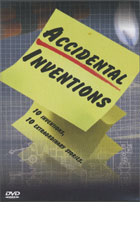
Accidental Inventions 2004
Distributed by Jumby Bay Studios, 11783 Borman Drive, St. Louis, MO 63146; 1-800-476-1991
Produced by Jumby Bay Studios
Director n/a
DVD, color, 84 min.
Sr. High - Adult
Business, History
Date Entered: 08/10/2004
Reviewed by Brian Falato, University of South Florida Tampa Campus LibraryAccidental Inventions looks at the creation of 10 products or processes that are in common use today: the microwave oven, the Post-It note, Velcro, stainless steel, developing fingerprints using superglue, strikable matches, Teflon, cellophane, dynamite, and ether anesthesia. What these inventions have in common is that the inventors were not consciously trying to create them, but rather stumbled upon them during the course of failed experiments involving other products, or were inspired to further investigate an unusual phenomenon they happened to notice.
For instance, the origins of cellophane lay in a failed attempt to make a better tablecloth. A scientist working at a defense plant got the idea for a microwave oven when the chocolate bar in his pocket melted from exposure to a magnetron, a microwave-generating tube used in radar. The Post-It note came about when an attempt to create a superglue failed because the glue would stick to only a small contact area rather than an entire surface. The creation of Velcro was inspired by a scientist’s study of the cockleburs that had stuck to him and his dog after a walk in a field in Switzerland.
Two areas that were especially interesting, because the stories were less known, were the sections on fingerprint fuming and strikable matches. Fingerprints which are difficult to gather from dusting can be lifted by using a process involving fumes from superglue. Matchsticks originally used white phosphorous, a much more hazardous substance than the red phosphorous currently used. Matchgirls who delivered matches in crates they carried on top of their heads would rapidly lose their hair because of exposure to the white phosphorous. And workers at matchstick plants would frequently die of a mouth cancer called phossy jaw.
A typical instructional style is used to tell the stories. A narrator relates the background and history of the invention, while teachers, scientists, and businesspeople offer more information about the specifics of the product and its importance. Notes frequently appear at the bottom of the screen providing additional facts. The presentation can be a little dry at times when the scientific specifics of an invention are discussed.
Each invention can be accessed separately through its own menu on the DVD. The individual menus contain bonus material for seven of the 10 sections that provide information on related aspects of the invention discussed. The sections on cellophane, Teflon, and Velcro lack bonus materials.
Also present on the DVD are an interactive quiz covering material presented in the stories and a teacher’s guide and historical patents that can be printed from Adobe Acrobat files when the DVD is used in a computer.
This DVD is useful for high school and introductory-level college courses. The general public can also find interesting information on this disc, even if the presentation is not very exciting.